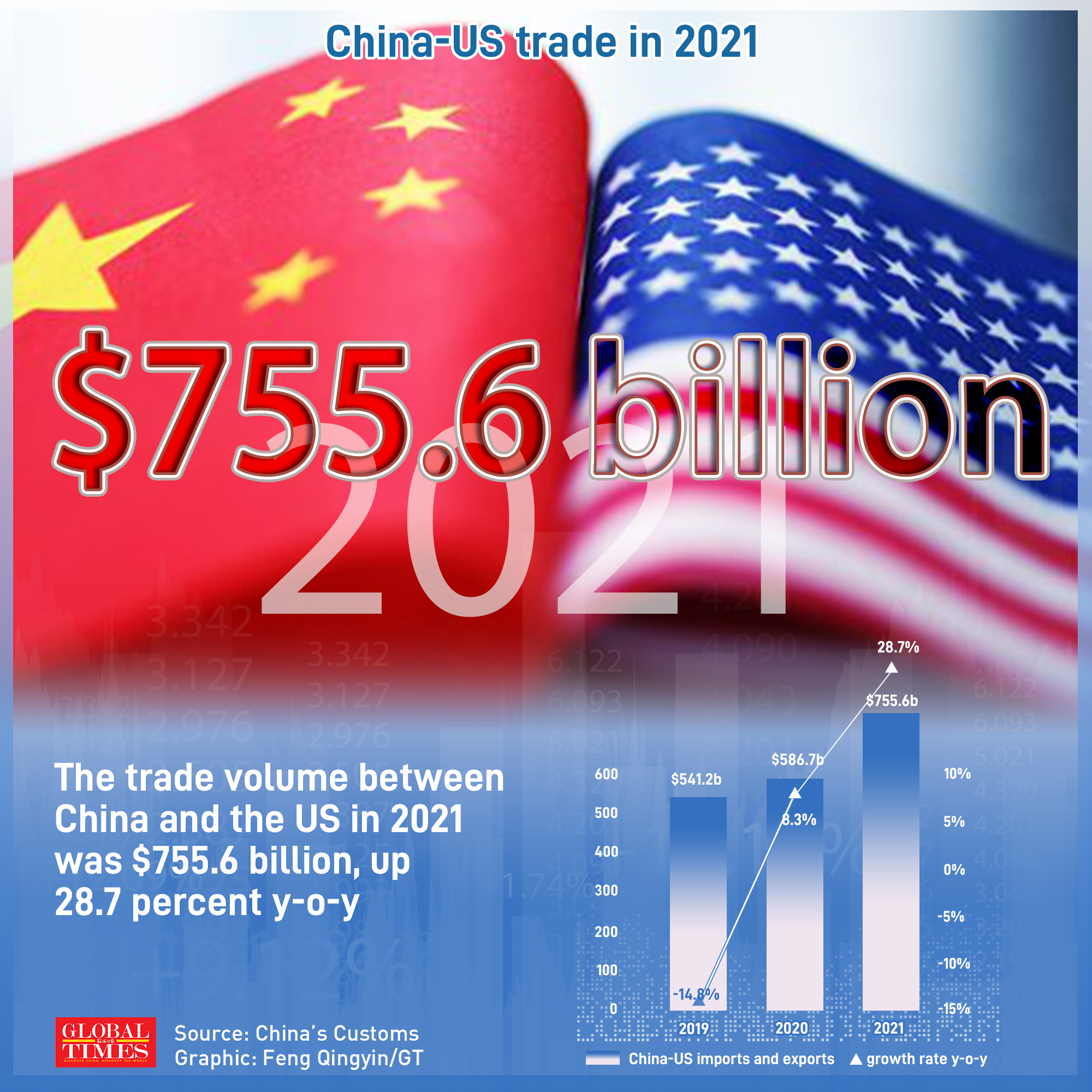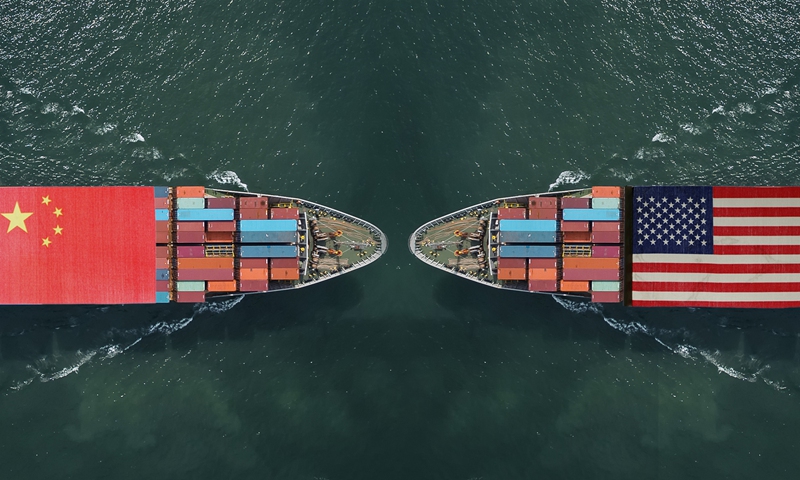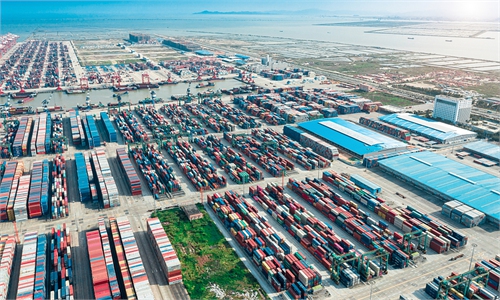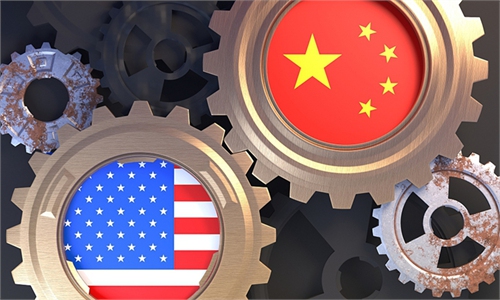US’ trade with China surges 28.7% in 2021, but widening deficit proves tariffs ‘a failure’

China's foreign trade in 2021. Graphic: Feng Qingyin/GT
Trade between China and the US soared by 28.7 percent and amounted to $755.6 billion in 2021 - maintaining a strong growth momentum and contributing 12 percent to China's record $6 trillion foreign trade for the year despite tariffs and bruising political tensions between the world's two largest economies.
The number, which comes just one day ahead of the second anniversary of the signing of the phase-one trade deal between China and the US, shows a strong complementarity between the world's two largest economies, while it is also a demonstration of China's goal to fulfill its commitments under the deal over the past two years, observers said.
According to Chinese Customs data released on Friday, China's exports to the US increased by 27.5 percent in 2021, while imports grew by 32.7 percent, reaching $179.53 billion.
The US maintained its place as China's third-largest trade partner following ASEAN and the European Union. China-US trade was twice China's trade with its fourth-largest trade partner Japan - which was 2.4 trillion yuan.
"The prospering trade numbers are within industry expectations, which proves the complementarity of China-US trade structure, and more importantly, that Washington's crackdown on and ideology war over China is a divorce from objective laws," He Weiwen, a former senior trade official and an executive council member of the China Society for World Trade Organization Studies, told the Global Times on Friday.
Friday's figures point to maintained growth momentum from 2020, when trade between the world's top two economies was back on a growth track, after a plunge in 2019 when bruising trade tensions clobbered bilateral imports and exports.
China's trade surplus with the US was $39 billion in December and $396.5 billion for 2021, further widening from a surplus of $357.5 billion in the first 11 months, according to the Global Times' calculations.
The surplus even widened from before the trade war in 2018, during which China's trade surplus with the US was $323.3 billion.
The widening was in stark contrast to US ambitions to reduce the gap - one of the key motivations for former US president Donald Trump to launch the trade war against China. Most of the additional tariffs have remained in place under the Biden administration.
The widening deficit proves that tariffs the US exerted on Chinese products "are a failure," and made-in-China products are irreplaceable, He Weiwen said.
"It's time for the US to scrap all the tariffs," He said.
A removal of additional tariffs has been the US business community's wish. "We'd like to see the tariffs mutually reduced or eliminated entirely … US jobs were lost and higher costs for imported items due to tariffs cost the average household over $400 per year," the US-China Business Council (USCBC) said in an interview with the Global Times via email.

China US Photo:Global Times
What's next?
Ahead of the two-year anniversary, there are also growing discussions about the results of the phase-one agreement and the next step for the world's two biggest economies.
Some in the US are asserting that China has failed to meet its target for purchases of US products and services, while many in China cited the US' escalating crackdown on Chinese firms and lingering tariffs and other restrictions, as well as uncontrollable external factors such as the pandemic.
The US crackdown on China's technology sector has expanded from 5G to artificial intelligence and biotechnology, in a desperate attempt to maintain its shaky tech dominance.
The amount of soybeans that China purchased and shipped from the US was estimated to be about 27 million tons, with a revenue of more than $14 billion, Zhang Xiaoping, country director for China at the US Soybean Export Council (USSEC), told the Global Times.
That amount accounted for more than one-fourth of China's total imports of soybeans over the past year, which was $53.54 billion.
The [phase-one] agreement… helps US soybean exports to China rapidly resume and continue to benefit industries and people of both countries, Zhang said.
The US soybean industry cherishes the partnership it has established with the Chinese industry, and is confident to welcome the 40th anniversary of serving China and the landmark 2022, Zhang told the Global Times.
Chinese Ministry of Commerce spokesperson Shu Jueting said on Thursday that since the phase-one deal came into force, China has worked to overcome several unfavorable factors, including the COVID-19 pandemic, a global economic recession, and supply chain disruptions, to push for the joint implementation of the deal.
"There is no doubt that the deal benefits both China and the US, as well as the world … Trade teams of the two sides are maintaining normal communications and if there is any further information, we will release it promptly," Shu said at a regular press conference in Beijing.
Trade can still be a buffer and cornerstone in China-US relations, observers said, while noting that first and foremost, China will firmly safeguard the interests of its firms and people.
It's possible that China's imports from the US might "surge on a large scale" in 2022 as there are many deals "under negotiation," Gao Lingyun, an expert at the Chinese Academy of Social Sciences in Beijing, told the Global Times on Friday.
Gao stressed that the purchases have to be based on fair prices and China's own demands.
Expansion of friend circle
Across the globe, China's trade topped $6 trillion in 2021, the first time in history, as the Chinese economy, a global forerunner in containing the COVID-19, continued a solid recovery over the past year.
Growth in 2021 hit $1.4 trillion, equivalent to the annual foreign trade in 2005, according to Customs data.
Apart from a growing trade with the US, the country also posted stellar gains in trade with almost all its major trading partners throughout 2021.
China's yuan-denominated trade with the ASEAN, its largest trade partner, increased 19.7 percent in 2021, while its trade with the EU and the US, its second and third largest trade partners, rose by 19.1 percent and 20.2 percent, respectively.
Its trade with economies involved in the Belt and Road Initiative (BRI) grew by 23.6 percent, 2.2 percentage points higher than the overall growth rate, Customs statistics showed.
In 2021, China's trade in yuan terms to the 14-member countries of the Regional Comprehensive Economic Partnership (RCEP) was also up 18.1 percent year-on-year, accounting for 30.9 percent of the country's total foreign trade.
"China's 2021 trade numbers prove its trade strategy is a balanced one, rather than a preference on the US and overlooking others under the phase-one deal as some have speculated," He Weiwen said.
A more diverse range of trade partners and an integrated Asia-Pacific industrial chain will offer China more leverage in its future trade talks with the US, observers said.
China's trade landscape faces rising uncertainty, instability and imbalance amid recurrent waves of the pandemic. That means the country's relevant advantage in taking the lead in the economic rebound might be weakening, Customs spokesman Li Kuiwen said at the press conference on Friday, noting that the country's resilience and strong economic fundamentals over the long run won't change, thereby vigorously underpinning a push to stabilize trade.





